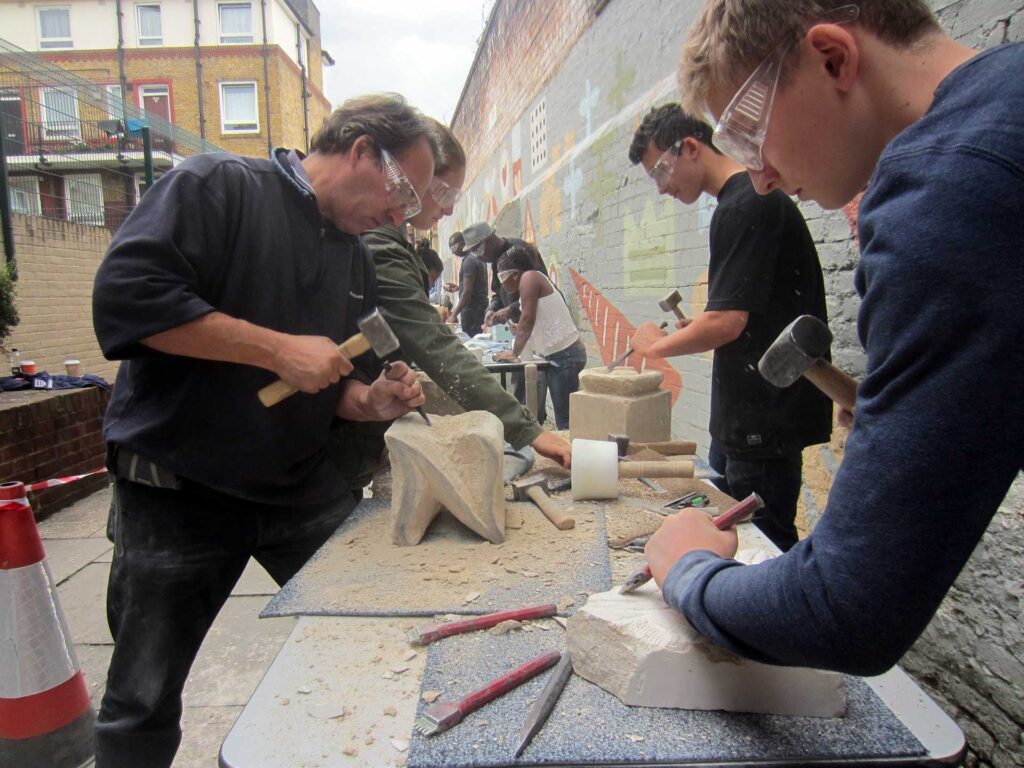
What do the sculptures mean for residents, the workshop participants and pledge supporters?
They are a living art heritage, connecting people across time, social and geographical boundaries. The work of yesterday’s stone masons – through the stones collected from historic buildings that Emery has worked on – exists alongside the contemporary work of today’s community. The Cornerstone brings people together through public artistic engagement, providing a sense of belonging and ownership. People form strong connections to each other, their neighbours and the wider community whilst making a major physical change to a public space.
The project helps overcome the challenges of gentrification and the ever-increasing wealth gap within inner city multi-cultural areas. By celebrating our diversity and creating opportunity for life-long established Londoners to work alongside immigrant new-comers, we form bonds based on equality, mutual respect and positive partnerships.
Who made community sculptures?
At the core are the stone carvings made by the work and creativity of over 100 local residents and others who spent many hours participating in stone-carving workshops for Cornerstone on the Whites Grounds Estate in 2013 and for The Shared on Tyers Estate in 2012. Emery assembled the individual stone carvings and other stones and components into two sculptures: The Shared unveiled in September 2014 and Cornerstone put into place in December 2020.
How big is Cornerstone?
It is made up of a series of six main cairns including hundreds of stones. It is over 8 metres long and the tallest cairn is about 2.5 metres high.
What are Cornerstone and The Shared made of?
A combination of Bath, Portland and various limestones. Cornerstone sculpture also includes marble, Victorian brickwork from the old London Bridge Station arches and some bones from the River Thames. It includes fragments from Westminster Abbey, the old Tanner Street Park fountain and Southwark Cathedral, alongside the pieces hand-carved by voluntary community participants. All pieces have been permanently fixed together with a combination of mortar, resin and stainless steel dowels.
Who organised the workshops?
The stone-carving workshops in 2012 and 2013 and following years were organized by artist and stonemason Austin Emery with support from the Bermondsey Street Residents Association (BSRA, which brings together representatives of Whites Grounds, Tyers, Tanner House and Snowsfield Estates), Leathermarket JMB and other organisations. The aim is to build sculptures made for and by the community members.
Have the sculptures won awards?
In 2012, Leathermarket JMB won a Southwark Council award for “most successful non-housing related project by a TMO (tenant management organisation)” for the community stone-carving workshops. The sculpture project also won Best Community Arts Project in 2013 from the Southwark Arts Forum.
What was the crowd-funding campaign for Cornerstone?
Crowdfunding was carried out through Spacehive, a “funding platform for ideas that bring local places to life” such as improving a park or a playground or starting a street market. Projects with backing from within communities can attract funding from councils, foundations and companies that might want to help. “The aim is to provide a powerful springboard for ideas that make communities happy, proud and prosperous.” The crowd-funding campaign for Cornerstone was supported by 205 local organizations, companies and individuals, many of whom who participated in the workshops. The Mayor of London was a major contributor. It uses hashtag #CrowdfundLDN.